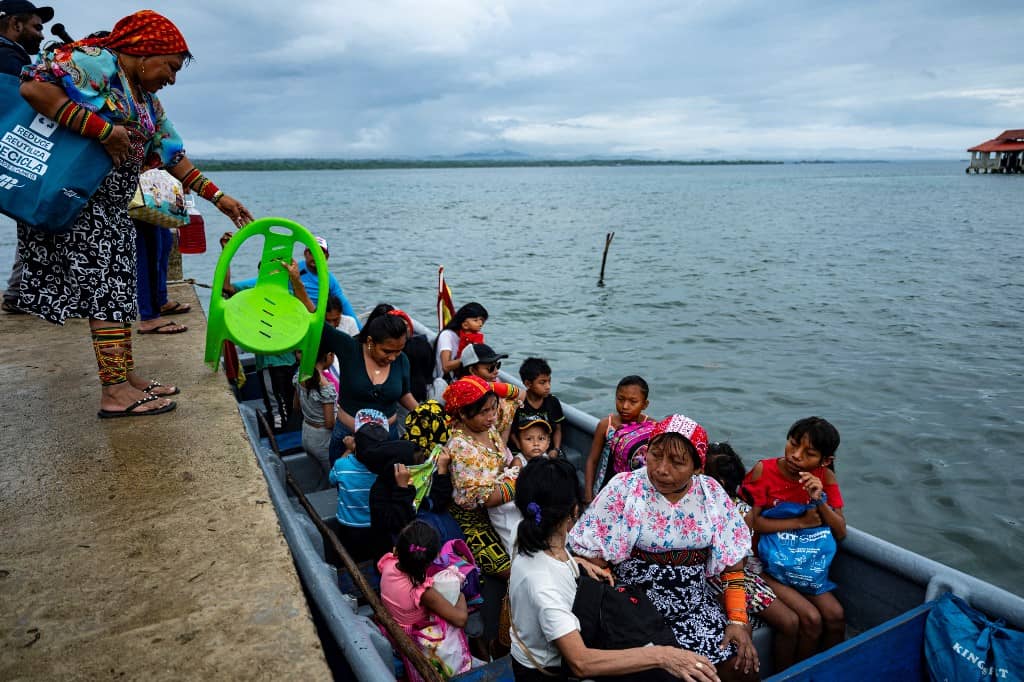Alberto López prepares his breakfast with water at his ankles. The day dawned rainy and his humble house was flooded on the tiny Panamanian island of Cartí Sugdupu, in danger of being devoured by the sea due to the effects of climate change. Since this Monday, the indigenous people who inhabit Cartí Sugdupu, one of the 365 islands of the Caribbean archipelago of Guna Yala, began to gradually move to the mainland.
López waits for the rain to stop to take a boat and bring clothes and belongings to what will be his new home in the Nuevo Cartí neighborhood, built on the coast by the Panamanian government to relocate the indigenous people. Slowly, he stirs pieces of chicken and plantain in the pan, while the rest of the house’s occupants wait for the rain to clear, lying in hammocks.
He lives in a house with a dirt floor and cane walls, which does not have electricity most of the day and also no sanitary service. Clothes are scattered and on a small table at the entrance, there are cleaning items and a Bible. “We feel sadness because if this island goes, part of our heart goes, part of our culture,” laments López, who was born on Cartí Sugdupu 72 years ago.
As a child, he fished, like most of the islanders, and worked in the fields on the mainland. His mother sent him to study in Panama City where he lived for more than 30 years, but when he retired, he knew he had to return. “I came here because my heart wanted me here and this house is the one my family left me,” says López, a thin man who has a heart tattooed on his left arm with the initials of his name and his mother’s last name.
“My grandmother, my grandfather and my aunt died here… it won’t be the same anymore, but I have to move forward because life goes on,” he adds.
We don’t fit here
In Cartí Sugdupu, the size of five soccer fields, its 1,200 inhabitants live overcrowded and without guaranteed basic services. There are communal bathrooms, where four crossed wooden boards serve as a toilet. They live from fishing, tourism and the production of cassava and plantain, which they collect in the continental area.
The population faces the constant rise of the sea, which regularly floods their homes. The Panamanian government calculates that Cartí Sugdupu will be swallowed by the sea by 2050. Several of the islands of Guna Yala are at risk of disappearing under the waters. The 49 inhabited islands are barely between 50 cm and one meter above sea level.
On this first day of transfers from Cartí Sugdupu, the police helped the indigenous people to mobilize their belongings to the coast in boats. “As a government, we are supporting this move. This is a process that seeks to allow those who do not have facilities to move,” stressed the Minister of Housing and Territorial Planning, Rogelio Paredes.
At a small dock, the agents loaded furniture, buckets of clothes, plastic chairs, some appliances and even a stuffed animal. “I am sad to leave this house, to leave all my family,” said Idelicia Ávila, sitting in the hammock of her house in Cartí Sugdupu.
“The island is not going to sink, we are moving because we don’t fit here,” adds the 42-year-old woman. This is the first displacement in Panama caused by climate change, although days ago the country’s president, Laurentino Cortizo, warned that other cases are being studied.
Brutal change
In Nuevo Cartí, the indigenous people will live in houses of 40.96 m2, with water and electricity, two bedrooms, living room, dining room, kitchen, bathroom and laundry area. Each house has a plot of 300 m2, useful for planting.
López will live in house number 256 with three sisters and a daughter. He plans to grow pumpkin, cassava, pineapple or plantain to sell. He already has thought about where he will place the stove and the refrigerator. He even talks about expanding it to accommodate new family members.
“We have everything to bathe, here I have everything complete, there (on the island) I don’t have that facility,” he says, showing the bathroom. “Surely everyone is happy, but it is a brutal change,” he says.






